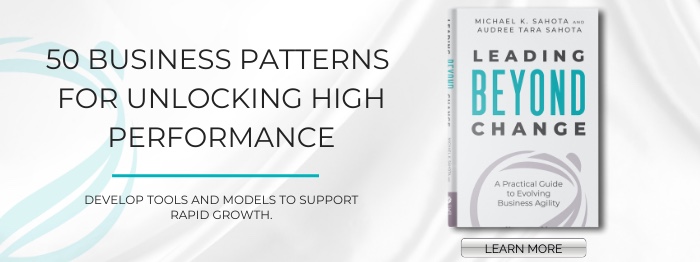The success of any transformation program such as Agile or Digital is wholly dependent on the culture of the organization. And 80% of organizations have a challenged or low-performance culture that is incompatible and block the introduction of innovative new ways of working.
Culture Eats Strategy for Breakfast
Most people are familiar with Drucker’s now-famous business maxim: “Culture Eats Strategy for Breakfast.” Our extension is to add that: “Strategy eats Tactics for afternoon tea.” Most change programs fall into the trap of focusing on tactics and strategy instead of culture. So creating a lasting shift in organizations requires a focus on culture all day long – not just for breakfast. Read more about tactics, strategy, and culture.
What’s even more interesting is that people can influence culture at all levels of the organization – without power, budget or authority. In fact culture usually evolves in Culture Bubbles – a powerful pattern for unlocking change. Culture change is open to anyone wanting to have impact – not just top leadership.
High-Performance Culture Is Necessary for Survival
Many organizations are now facing what we call the VUCA world: volatile, uncertain, complex, and ambiguous. Organizational leaders find that the world is changing so rapidly that it’s hard for their products and services to keep up with change. It’s challenging to keep up with competitors and meet the needs of an evolving marketplace.
Organizational Survival Is Optional
Organizations are going out of business at a faster and faster rate. Just because an organization has been around for a hundred years does not guarantee that it will continue to exist. Organizations are faced with a choice: either innovate and evolve or go extinct.
Even in a stable industry, once an innovator has entered your marketplace, your organization will not have the time to respond. That’s the importance of a high-performance culture. If your organization doesn’t have it, it may not survive.
What Does High-Performance Culture Look Like?
What does it really mean to have a high-performance culture? Fundamentally, it’s about creating success and achieving the purpose of the organization. Of course, organizations define that differently, yet whatever an organization’s definition of success, there’s one thing that ties them all together. The culture is one where people come together and are motivated to deliver for the organization, because they want to. Or to be more blunt the workers have a strong desire for the success of the organization.

There are many models that attempt to define high performance culture such as Frederic Laloux’s model of Teal. When we extract the essence of all the various models, what we find is that it all comes down to the people.
It’s About People
When you have a group of people who are excited, motivated, and ambitious, you’re going to see better results. People who are passionate and motivated can overcome any kind of obstacle. They’ll figure out a way to work around it and create organizational success. Thus, the core of high-performance culture is engaged, motivated people.
Some common characteristics of organizations with high-performance cultures include:
- People are learning and growing every day
- Employees are passionate, motivated, and engaged
- There’s a strong sense of purpose; a clear vision
- There’s a shared agreement about how people work together
- People feel psychologically safe
- People have equal voice; everyone can speak up to help make the best decision possible
A high-performance culture is not an end state, it’s a journey. A transformation program alone won’t get you there. Rather, it’s a daily process to make continual progress on the journey.
Daily Activities to Create a High-Performance Culture
If a high-performance culture is so important, how do you create one? Here are some practical steps leaders can take to develop a high-performance culture in their organization.
Act as a Role Model
The most valuable thing a leader can do is to act as a role model. To model the future ways of working and ways of being that you hope to see in the organization. The rate of an organization’s evolution is determined by the rate of its people’s evolution, and the best way to impact that is to act as a role model.
Let’s imagine that you’re not seeing people take on as much responsibility as you’d like them to. The recommended action is to consider, where are you in taking on more responsibility as a leader? Where could you be more responsible? Where are you lacking in desire to engage in the organization?
If we want people to be more responsible, then they need some sort of ownership. So another question to ask is, where are you giving space for people to have ownership? Do people have the space to take responsibility for things? Do you trust others to be responsible?
In both cases, you’re taking responsibility and modeling the change that you wish to see. How are you showing up as a leader who create leaders?
Share Decision-Making
In many organizations, there is a hierarchy where decisions are moved up and up and up the ladder. A very simple practice for a leader to create learning capabilities in their organization is to move those decisions down.
What often happens when you move decisions down to more junior employees is they come up with radical ideas and innovations. And when they’re taking charge, they also learn how to lead that project better. They may not be the most expert, but if they have passion and ownership, they’re going to be motivated to make it successful.
When those people are in a place where they can get advice from other people who can help them be successful, you’re off to the races because now you’re developing an organization that’s learning. So the organization is able to accomplish more, not just this month, but the next month too. We created the Decision Cards deck to help leaders choose who is responsible for each decision.
Talk Less, Listen More.
The simple practice of listening first and talking last creates space for innovation to happen. When the most senior person always speaks first, the space for innovation drops because nobody else gets to contribute ideas. Nobody wants to contradict the leader and people think, “What they said is good enough.”
When we create a space for others to contribute new ideas, not just through brainstorming sessions but in regular daily meetings, that leads to a shift in innovation capabilities.
Look After the People
The other thing leaders can do to create high-performance culture is to really look after the people. Oftentimes leaders are focused on results and getting things done. But everything that gets done is actually accomplished by people. Thus, the secret to a high-performance culture is to look after people. Understand what motivates them and what inspires them and connect with them to make sure that they’re looked after.
For example, when you check on a project’s status, instead of asking about the date and the timeline, ask, “How are the people doing? What’s going on with people? What are people frustrated about, and how can I help?”
Create Spaces to Explore the Future
The other thing that leaders can do is to create spaces to allow people to explore the future. Create opportunities to ask, “What kind of organization do we want to be?” This helps to create a clear sense of purpose.
Do people have a sense of shared inspiration? Do they have a shared desire for what they want to create for the organization? Without this, it’s difficult to create a truly high-performance culture.
Unblock the Organizational System
It’s important to look at the infrastructure, processes, and rules of an organization to see whether they are helping people or getting in their way.
One approach is to convene a group of people who are interested in making the organization better. Ask questions like, “What are the biggest challenges that span across groups or divisions that we can work on to move us more towards our star on the horizon?”
Look at Areas of Tension
The next thing a leader can do is to look at tensions in the organizational system. It’s a concept from S3 or sociocracy, which is to look at the places where things aren’t working that well. Noticing problem areas where there’s a recurring pattern, or there’s some sort of interpersonal challenge or there’s tension between groups. And when we look for these tensions, then we can help steward the system and help it move towards resolution of these tensions.
And it’s not very complex. You can simply say, “Hey, I notice a bit of challenge around this. What do you guys think?” And just listen to see if people agree. And if they agree then say, “Well, how big a problem is this for us? How valuable is it to resolve this tension?”
Then actually work as a steward of the system to look after it.

How To Evolve Your Culture
Evolving to a high-performance culture means moving to a people-centric model of interaction. While it sounds simple, it is not an easy shift. In order to support leaders in achieving both the level of inner growth and as well as the skills and tactics needed to create a high-performance culture, we offer a variety of courses that will support you on your journey.
In this post we have outlined how you can immediately start to make a culture shift locally simply by making different choices for how and where to engage. To learn further we refer you to a related post How To Change Your Organizational Culture or get immediate access to in-depth information via our Agile Leadership and Transformation Training.



